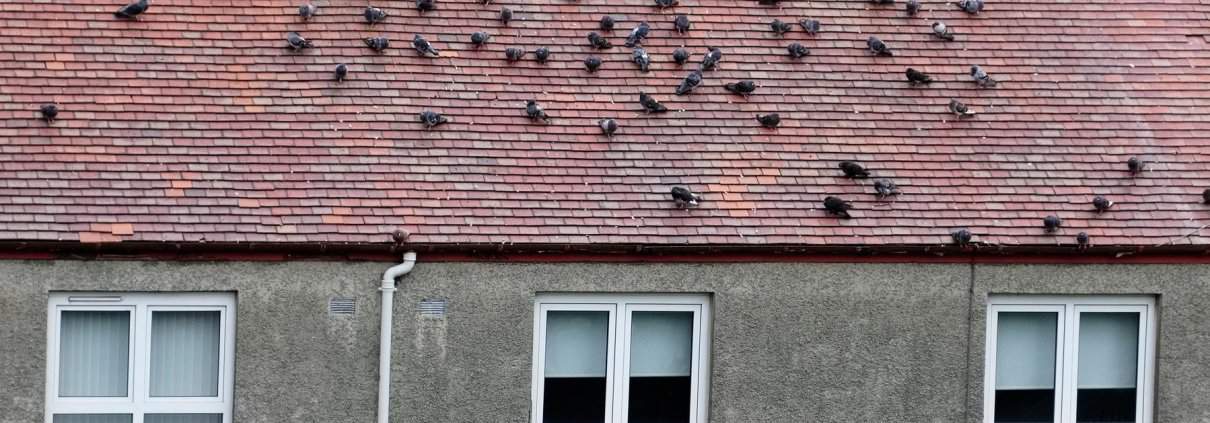Rooftop Bird Control: Why Rooftops Become Bird Havens in Summer and How to Stop It
Rooftops offer a perfect storm of conditions that attract pest birds during the summer. Elevated from predators, warmed by the sun, and often near food sources, they become prime real estate for nesting, roosting, and shelter. For property owners and pest control professionals, these high places can quickly turn into maintenance nightmares without proper control strategies.
Why Birds Flock to Rooftops During Summer
Heat Retention Creates Thermal Comfort
Materials like asphalt, tar, concrete, and metal absorb heat throughout the day and radiate it during the night. This makes rooftops comfortable spots for birds seeking warmth, especially pigeons, starlings, and gulls. The rising air currents around buildings can also assist in effortless flight, conserving energy for birds that nest or roost nearby.
Height Provides Safety from Predators
Elevated structures offer birds a clear line of sight and minimal disturbance from people and animals. Utility fixtures like HVAC units, satellite dishes, and parapet walls create secure perching and nesting spots that are rarely interrupted.
Access to Food is Convenient
Birds are highly opportunistic feeders. Rooftops near restaurants, dumpsters, or loading zones provide easy access to waste and discarded food. This proximity encourages birds to set up nearby roosting or nesting zones, cutting down the distance they need to travel between feeding and resting.
Drainage and Pooling Water Offer Resources
Flat roofs often collect standing water from rainfall or HVAC discharge. These mini water bodies attract birds for drinking and bathing. Insects drawn to the water also become a secondary food source, reinforcing the area’s appeal.
The Hazards of Rooftop Bird Activity
Birds on rooftops create risks beyond aesthetic damage. Their droppings are acidic and can corrode roofing materials, HVAC systems, and structural components. Nests clog drainage systems and increase water damage risk. In commercial settings, bird activity may lead to sanitation violations and even equipment warranty voids. Slippery droppings near rooftop access points can also become liability hazards.
How to Prevent Birds from Nesting or Roosting on Rooftops
Use Physical Exclusion Tools
The most effective way to stop birds from using your roof is to deny them access.
- Bird Spikes: Bird-X Stainless Steel Spikes (STS Series) and Plastic Spikes (SP Series) physically prevent birds from perching. Ideal for ledges, parapets, signs, and flat surfaces.
- Bird Wire & Post Systems: This low-visibility solution creates unstable landing zones with tensioned wire. Use BW-WIRE and compatible posts, crimps, and clamps for long-lasting installations.
- Bird Netting: Premium Bird-X Netting (NET-PE Series) creates full exclusion zones over HVAC units or recessed mechanical areas. Proper installation includes turnbuckles, ferrules, and corner attachments to maintain tension.
- AviAngle®: Designed for ledges, AviAngle’s sloped surface prevents birds from achieving a foothold. Suitable for architectural elements with 90-degree angles.
Apply Sensory and Behavioral Deterrents
Make the rooftop less inviting using materials that disrupt bird senses.
- Optical Gel: This low-profile deterrent deters birds using sight, smell, and texture. Optical Gel (BP-CUP-OG) dishes can be discreetly placed along perching zones and corners.
- Avishock™ Track: Delivers a mild, humane shock to birds, teaching them to avoid treated surfaces. Avishock is ideal for structures where visual aesthetics matter.
Install Electronic Repellent Systems
Electronic systems are effective for larger rooftops or sites with persistent infestations.
- BroadBand PRO: Combines sonic and ultrasonic sounds through four directional speakers. Mimics predator calls and distress signals.
- BirdXPeller® PRO / Super BirdXPeller® PRO: Species-specific distress calls cover 1–6 acres. Ideal for deterring pigeons, sparrows, gulls, and more.
- Outdoor Laser II: A soundless solution using randomized green and red laser patterns to disorient birds. Best suited for quiet environments or residential rooftops.
Preventive Practices for Facility Managers and PCOs
Survey and Maintenance
- Inspect for droppings, nests, and debris regularly
- Clean and disinfect surfaces using Bird-X Evo Blend Cleaner (BX-EVO)
- Secure rooftop trash bins and remove standing water
- Remove inactive nests after the migration season (check legal restrictions)
Secure Entry Points
- Screen vents, gaps, and conduit entries using mesh or netting
- Use the Bird-X Solar Mesh Kit around solar panels to prevent birds from nesting underneath without affecting panel warranties
Rooftop Bird Control Reference Checklist
Inspection and Planning
- [ ] Identify species and roosting behavior
- [ ] Locate access points, nesting materials, and signs of feeding
Installation and Exclusion
- [ ] Apply bird spikes or wire along parapets and signs
- [ ] Install netting over mechanical equipment
- [ ] Use AviAngle for ledge-based perching
Behavioral Deterrence
- [ ] Position Optical Gel or Avishock Track in high-traffic areas
- [ ] Program sonic or ultrasonic deterrent systems
Ongoing Maintenance
- [ ] Clean regularly with bird-safe disinfectants
- [ ] Monitor exclusion tools for wear and effectiveness
- [ ] Adjust deterrents seasonally
Birds seek out rooftops in summer for warmth, security, and proximity to resources. While their presence may seem harmless at first, the resulting damage, sanitation issues, and liability risks make effective bird control essential.
A successful rooftop bird control plan combines physical barriers, behavioral deterrents, and consistent maintenance. Bird-X provides a wide array of field-tested solutions—including Bird Spikes, Netting, Avishock™, Optical Gel, and programmable sonic systems—tailored for commercial and industrial sites. For assistance selecting the right tools or guidance on complex installations, consult with the Bird-X technical support team.




Leave a Reply
Want to join the discussion?Feel free to contribute!